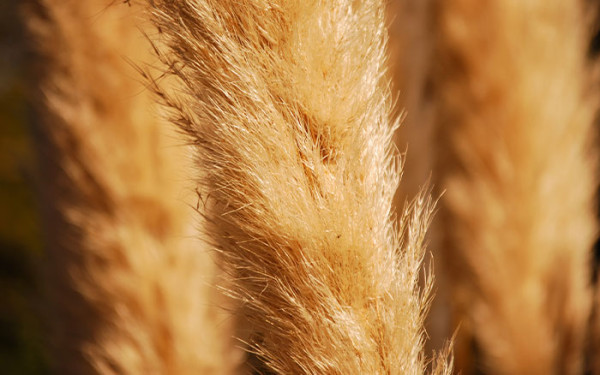Have you ever been mesmerised by the sight of a field of ripe, golden corn gently swaying in the breeze? It’s so gently relaxing. So, did you know it’s possible to create the same effect at this time of year in the garden with ornamental golden grasses?
There are many different types of grasses, several of which develop beautiful, burnished bronze golden tones, which last right the way through the winter until mid-February. So, here’s a selection of some of the best golden grasses to choose from…
Calamagrostis x acutiflora (reed grass)
These are a very beautiful group of trouble free, upright growing grasses that soon form dense clumps of fine leaves. The plants produce strongly upright stems that start to turn a soft, light brown colour from late summer. They remain rigidly upright without collapsing, right the way through to early spring. At this time, they should be cut down to just above ground level.
Reed grass grow well in well-drained soil in either sun or part shade.
Calamagrostis x acutiflora ‘Karl Foerster’ has a very defined, well-behaved, tall, upright shape that keeps its rigidity for months on end. As a result, this is a great choice for a modern, minimalistic style planting scheme.
Calamagrostis x acutiflora ‘Overdam’ is not quite as rigid as ‘Karl Foerster’ and has white stripes on its leaves. Therefore, this makes a great choice for planting in a darker area in the garden.

Molinia (moor grass)
Molinia (moor grass)
Moor grasses have thin, wispy, slender leaves, giving them a more relaxed, airy look. So, they’re ideal choices for a more naturalistic style of design. They tend to fall into two groups, those which are relatively short, and those that produce much taller flower stems. Both groups are hardy and clump forming.
They develop purple flowers in late summer. Along with the leaves, these turn wonderful shades of golden bronze as they age.
Molinia are very easy to grow and care for if given soil that stays moist. They can be grown in full sun or partial shade. Place them in the border where light can shine through them for the best effect and, if you can, plant a group of them en masse.
If choosing Molinia, it’s important to remember their stems have a tendency to suddenly collapse in January. So be prepared to cut them back hard to just above ground level before they collapse. Also, if space allows, place some of the hollow stems in a neat pile at the back of the border to give insects a place to hide out and hibernate in.
Molinia caerulea subsponsor. caerulea ‘Moorhexe’ is a low growing cultivar with stiff upright leaves which looks particularly effective in rock gardens, reaching a height and spread of 45cm.
Molinia caerulea subsp. caerulea ‘Strahlenquelle’ is a bit of a mouthful to say but is a beautiful type of moor grass that grows to a medium height of 90cm and width of 60cm. It’s an ideal plant for the middle of the border.
Molinia arundinacea ‘Skyracer’ is, as its name suggests, a tall, upright, elegant variety that reaches heights of up to 240cm when in flower. Its autumn colours are stunning and its architectural form makes it an ideal choice for a naturalistic planting scheme.

Hakonechloa (Japanese forest grass)
This is a very popular grass with garden designers as it works particularly well in both modern and naturalistic planting schemes. It’s a well-behaved, low growing grass that looks wonderful edging paths. As well, it looks great planted en masse around the base of medium height trees. It can also be planted in containers and its blooms are very popular with florists who use them dried in floral arrangements too.
The glory of this grass is that the elegant, arching leaves look stunning during the autumn and winter months as they turn a rich, bronze, copper colour.
Hakonechloa grow best in a humus-rich, moist soil, preferably in shade, but they will grow well in sun if the ground remains reliably moist. As with the other grasses above, it’s best to remove all the leaves before new growth starts in the spring, cutting them to just above the soil surface. They grow particularly well if given a thick mulch of compost or well-rotted manure after cutting back.
Hakonechloa macra ‘Aureola’ has leaves that are striped yellow and green and can develop a red tinge if grown in full sun. Like Hakonechloa macra, it reaches a modest height and width of 40cm x 40cm, thriving in the same growing conditions.

Stipa (feather grass)
Next is another group of easy to care for, handsome grasses. Again, there are different cultivars of different heights. The two which delight with bleached or bronzed foliage over the winter months are Mexican feather grass plants and oat grass.
They both grow well in well-drained soil in full sun.
Stipa tenuissima (Mexican feather grass) is a relatively shorter growing plant, reaching a height and spread of 60cm x 30cm. These plants are wonderfully tactile, so are best appreciated planted where hands can run through their soft stems when passing. Therefore, the front of a border or containers by a seating area are best.
Their wispy, fine green leaves produce silvery-green flowers during the summer months. These mature to a bleached blonde colour from autumn right the way through to spring. They move gently in the wind creating a relaxing environment in the garden.
Combing through the foliage in early spring will release and remove much of the dead foliage allowing fresh green growth to shine through.
Stipa gigantea (oat grass)
By contrast, oat grass produces tall, stiff softly bleached colour stems with flowers that look like oats during late summer. They look particularly striking if grown in thick clumps. Often reaching a height and spread of 180cm x 120cm, it’s immensely relaxing seeing their tall spires gently swaying in the breeze.


Leave A Comment